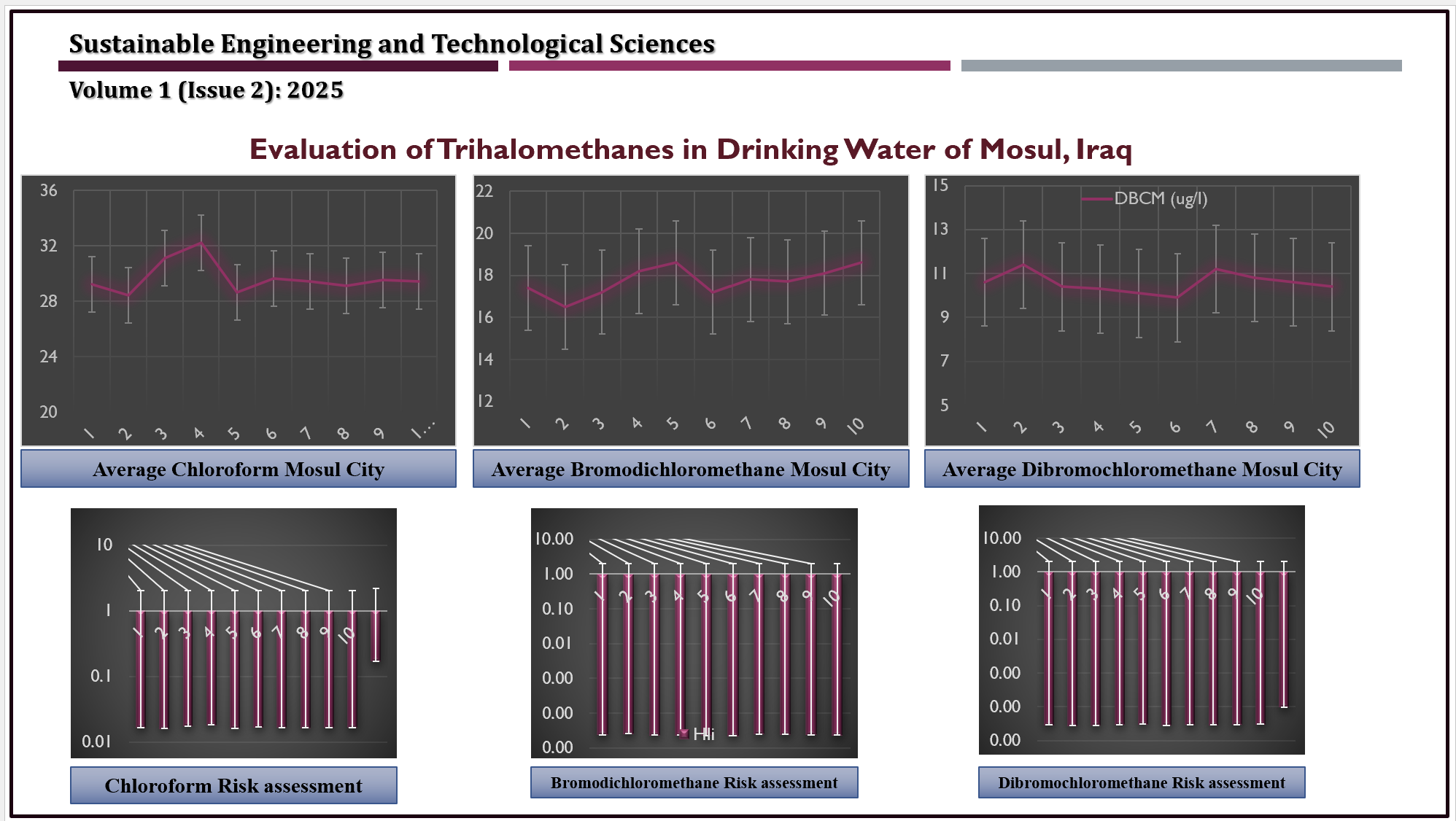Evaluation of Trihalomethanes in Drinking Water of Mosul, Iraq
DOI:
https://doi.org/10.70516/n5ppe973Keywords:
Trihalomethanes, Water Quality, Risk Assessment, Drinking water safetyAbstract
This study investigates the occurrence and associated health risks of trihalomethanes (THMs)—specifically bromodichloromethane (BDCM), dibromochloromethane (DBCM), and bromoform (BF)—in the domestic water supply of Mosul, Iraq. Water samples were collected from ten locations across the city between 2019 and 2020, including Al-Zuhoor, Al-Muthanna, Al-Sukar, Al-Mansour, Al-Majmoua Al-Thaqafiya, Al-Wahda, Al-Maliya, Al-Hadbaa, Al-Arabi, and Al-Tamim neighborhoods. Analysis was performed using gas chromatography with electron capture detection (GC-ECD) following USEPA Method 551.1. THM concentrations ranged from non-detectable to 69.4 μg/L, remaining below the WHO guideline of 100 μg/L. Health risk assessments were conducted using both WHO and USEPA models. Non-carcinogenic risks via ingestion pathways were found to be within acceptable limits (hazard quotient < 1), while the estimated total lifetime cancer risk from combined exposure (1.03 × 10⁻⁶) slightly exceeded the USEPA benchmark of 1.0 × 10⁻⁶, a threshold typically used for carcinogenic risk, indicating a marginal yet notable concern. The assessment primarily focused on oral ingestion, and further investigation into inhalation and dermal pathways, as well as impacts on sensitive subpopulations (e.g., children, elderly), is recommended. To mitigate potential health risks, improvements in water treatment—such as the implementation of advanced technologies like activated carbon filtration and better optimization of chlorination practices—are advised. The findings contribute valuable insights into water quality management and chemical exposure in urban environments of developing regions.
Downloads
References
S. Chowdhury, (2013) “Exposure assessment for trihalomethanes in municipal drinking water and risk reduction strategy,” Science of the Total Environment, vol. 463-464, pp. 922–930, 2013. DOI: https://doi.org/10.1016/j.scitotenv.2013.06.104
P. Ioannou, P. Charisiadis, S. S. Andra, and K. C. Makris, (2016) “Occurrence and variability of iodinated trihalomethanes concentrations within two drinking-water distribution networks,” Science ofThe Total Environment. Part A, pp. 505–513, 2016. DOI: https://doi.org/10.1016/j.scitotenv.2015.10.031
W. B. Y. Jianrong,W.Wuyi, Y. Linsheng, T. Jing, and H. Zhijiu, (2010) “Spatial and temporal evaluations of disnfection by-products in drinking water distribution system in Beijing, China,” Science of the Total Environment, vol. 408, pp. 4600–4606, 2010. DOI: https://doi.org/10.1016/j.scitotenv.2010.06.053
T. Karanfil, S.W. Krasner, P.Westerhoff, andY.F.Xie, “Disinfection by-products in drinking water: Information, occurrence, health effects and control,” American Chemical Society, vol. Washington, DC, USA, pp. 2–19, 2008. DOI: https://doi.org/10.1021/bk-2008-0995.ch001
S. Pan,W. An, H. Li,M. Su, J. Zhang, and M. Yang, (2014) “Cancer risk assessment on trihalomethanes and haloacetic acids in drinking water of China using disability-adjusted life years,” Journal of Hazardous Materials, vol. 280, pp. 288–294, 2014. DOI: https://doi.org/10.1016/j.jhazmat.2014.07.080
E. Righi, P. Bechtold,D. Tortorici et al., (2012) “Trihalomethanes, chlorite, chlorate indrinkingwater and risk of congenital anomalies: a population-based case-control study in Northern Italy,” Environmental Research, vol. 116, pp. 66–73, 2012. DOI: https://doi.org/10.1016/j.envres.2012.04.014
D. Stalter, E. O’Malley, U. von Gunten, and B. I. Escher, (2016) “Fingerprinting the reactive toxicity pathways of 50 drinking water disinfection by-products,” Water Research, vol. 91, 2016. DOI: https://doi.org/10.1016/j.watres.2015.12.047
Y. Komaki, B. J.Mari˜nas, and M. J. Plewa, (2014) “Toxicity of drinking water disinfection byproducts: Cell cycle alterations induced by themonohaloacetonitriles,” Environmental Science and Technology, vol. 48, no. 19, pp. 11662–11669, 2014. DOI: https://doi.org/10.1021/es5032344
M. J. Plewa, J. E. Simmons, S. D. Richardson, and E. D. Wagner, (2010) “Mammalian cell cytotoxicity and genotoxicity of the haloacetic acids, a major class of drinking water disinfection by-products,” Environmental and Molecular Mutagenesis, vol. 51, no. 8-9, pp. 871–878, 2010. DOI: https://doi.org/10.1002/em.20585
M.B.Rahman, T. Driscoll,C.Cowie, andB. K. Armtrong, (2017) “Disinfection by-products in drinking water and colorectal cancer: a meta-analysis,” International Journal of Epidemiology, vol. 39, no. 3, pp. 733–745. DOI: https://doi.org/10.1093/ije/dyp371
R. Sayess, A. Khalil, M. Shah, D. A. Reckhow, and K. J. Godri Pollitt, (2017) “Comparative cytotoxicity of six iodinated disinfection byproducts on nontransformed epithelial human colon cells,” Environmental Science & Technology Letters, vol. 4, no. 4, pp. 143–148, 2017. DOI: https://doi.org/10.1021/acs.estlett.7b00064
S. D. Richardson, M. J. Plewa, E. D. Wagner, R. Schweny, and D. M.Demarini, (2007) “Occurrence, genotoxicity and carcinogenicity of regulated and emerging disinfection by-products in drinking water: a review and roadmap for research,” Mutation Research/ Reviews inMutation Research, vol. 636, pp. 178–242, 2007. DOI: https://doi.org/10.1016/j.mrrev.2007.09.001
M. J. Plewa, M. G. Muellner, S. D. Richardson et al., (2008) “Occurrence, synthesis, and mammalian cell cytotoxicity and genotoxicity of haloacetamides: An emerging class of nitrogenous drinking water disinfection byproducts,” Environmental Science & Technology, vol. 42, no. 3, pp. 955–961, 2008. DOI: https://doi.org/10.1021/es071754h
S. R. Bielmeier, A. S. Murr, D. S. Best et al., (2007) “Effects of bromodichloromethane on ex vivo and in vitro luteal function and bromodichloromethane tissue dosimetry in the pregnant F344 rat,” Toxicology in Vitro, vol. 21, no. 5, pp. 919–928, 2007. DOI: https://doi.org/10.1016/j.tiv.2007.01.017
S.W. Krasner, (2009) “The formation and control of emerging disinfection by-products of health concern,” Philosophical Transactions of the Royal Society A: Mathematical, Physical and Engineering Sciences, vol. 367, no. 1904, pp. 4077–4095, 2009. DOI: https://doi.org/10.1098/rsta.2009.0108
S. W. Krasner, M. S. Dale, C. F. T. Lee, E. A. Garcia,W. Mitch, and U. Von Gunten, (2010) “Effect of water quality and operational parameters on DBP formation during chloramination: NDMA versus halogenated DBPs,” in Proceedings of the Annual Conference, AmericanWaterWorks Association, p. 46, 2010.
L. Liang and P. C. Singer, (2003) “Factors influencing the formation and relative distribution of haloacetic acids and trihalomethanes in drinking water,” Environmental Science & Technology, vol. 37, no. 13, pp. 2920–2928, 2003. DOI: https://doi.org/10.1021/es026230q
E. M. R. Souaya, A. M. Abdullah, and M. Mossad, (2015) “Factors affecting on formation of DBPs in greater Cairo drinking water,” Organic Chemistry: Current Research, vol. 4, no. 5, p. 2, 2015. DOI: https://doi.org/10.4172/2161-0401.S5-002
B. Ye, W. Wang, L. Yang, and J. Wei, (2011) “Formation and modeling of disinfection by-products in drinking water of six cities in China,” Journal of Environmental Monitoring, vol. 13, no. 5, pp. 1271–1275, 2011. DOI: https://doi.org/10.1039/c0em00795a
S. E.Hrudey and J.W. A. Charrois, (2012)Disinfection By-products and Human Health, IWA Publishing, London, UK, 2012. DOI: https://doi.org/10.2166/9781780400624
T. Bond, J. Huang, M. R. Templeton, and N. Graham, (2011) “Occurrence and control of nitrogenous disinfection by-products in drinking water - a review,” Water Research, vol. 45, pp. 4341– 4354, 2011. DOI: https://doi.org/10.1016/j.watres.2011.05.034
RAIS (2005). Risk Assessment Information System. Accessed at http://rais.ornl.gov/homepage/rap_docs. shtml, 3 December, 2009.
WHO (2005). Trihalomethanes in drinking water: Background document for development of WHO guidelines for drinking water quality.WHO/SDE/WSH/05.08/64.
IRIS (2005). Integrated Risk Information System. Cincinnati, Ohio: United States Environmental Protection Agency. Accessed at http://www.epa.gov/iris, December, 2009.
USEPA., Controlling Disinfection By-Products and Microbial Contaminants in Drinking Water, EPA: 600-R-01-110, United States Environmental Protection Agency, 2013.

Downloads
Published
Issue
Section
Categories
License
Copyright (c) 2025 Zinah A. Alshrefy (Author)

This work is licensed under a Creative Commons Attribution 4.0 International License.
Open Access and Copyright: SETS operates as an open-access journal, making all its articles freely available to everyone. Published content is licensed under the Creative Commons Attribution International Public License (CC BY 4.0). This license allows individuals and organizations to:
- Download, share, distribute, and print full texts of articles
- Reproduce or link to articles in any medium,
While authors retain copyright for their published work on the SETS website, the journal actively promotes and tracks citations to increase recognition for their research.
In essence, CC-BY-4.0 encourages the widest possible dissemination and utilization of published articles as long as written permission and appropriate credit are given to the authors.







